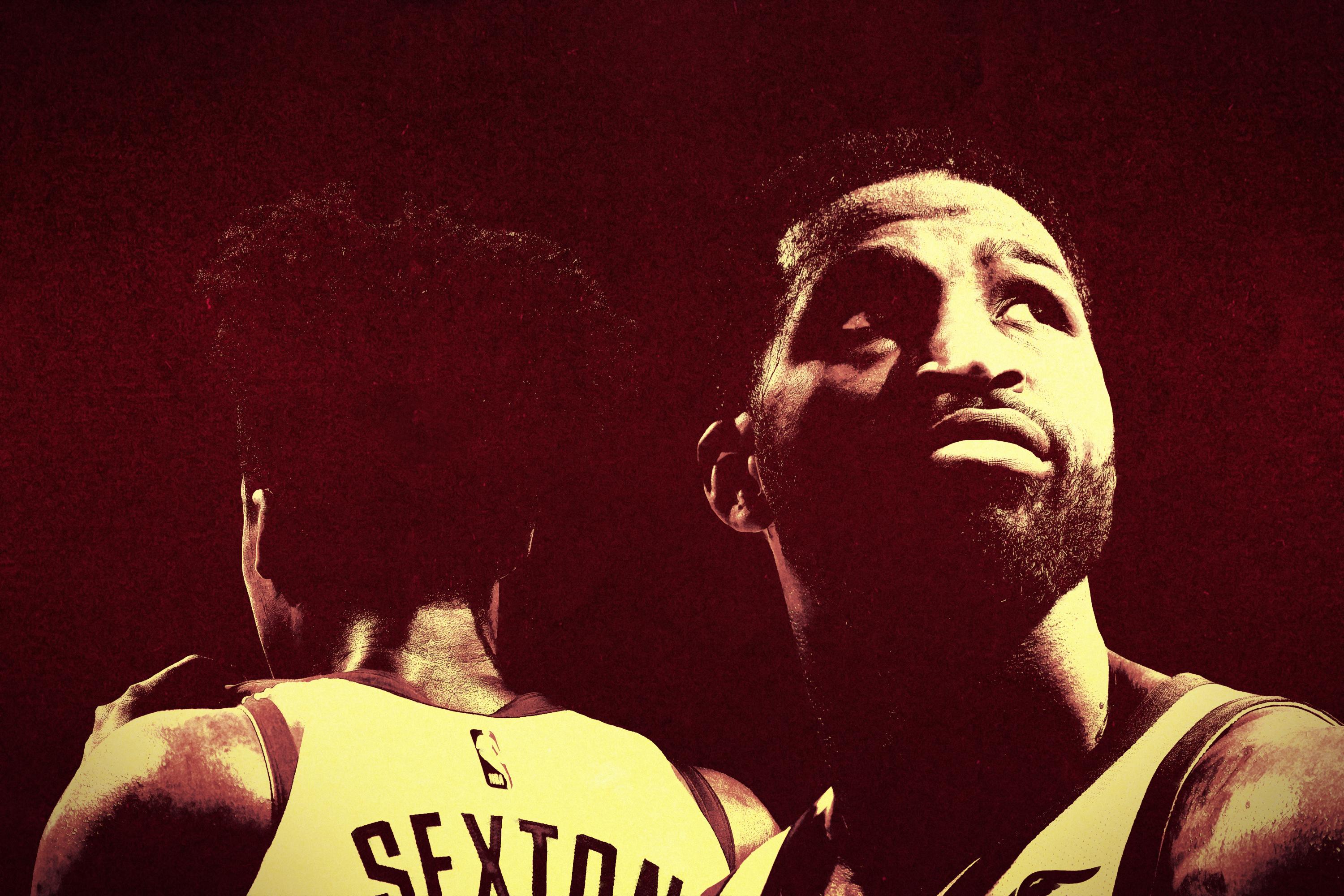
The Cavaliers met their maker on Wednesday, just as they did on December 2, 2010—the first time LeBron James made an appearance in the Quicken Loans Arena as a visiting player, then as a member of the Miami Heat. Those Cavs lost by 28, overwhelmed by both Miami’s front-end talent and the gravity of the situation before them: They weren’t just asked to win a game, they were asked to give the fans a reason not to lick their wounds. These Cavs, in their first major nationally televised game of the season, carried a different air. They fought hard for points, scrapped for offensive rebounds, and hit shots they hadn’t been making all season. Ultimately, it still wasn’t enough. Cleveland lost to L.A. 109-105. Odds are, that was the first time most people have tuned into the Cavaliers this season. Their prime-time ESPN performance wasn’t too bad a first impression, but it wouldn’t be the worst decision if this was the last Cavs game most people catch in 2018-19.
Not many games moving forward will have the built-in drama necessary to sustain interest in these sinking Cavs. Now at 2-14 on the season, Cleveland is firmly the worst team in the NBA. But comparing their specific brand of bad to the dregs of the league somehow feels negligent—a discredit, even, to Cleveland’s now-recurring experience of witnessing hope metaphysically separated from its chosen sports avatar. The Cavaliers as presently constructed (or, as presently ravaged) without LeBron are what Mortal Kombat games cut away from after a fatality sequence ends. Sure, we on the outside of the machine get a chance to regroup, reset, and select another character after the rounds are over, but offscreen, in some obscure, pixelated purgatory, is an eviscerated body still lying next to its own digi-spinal column. For the past four seasons, LeBron was Cleveland’s backbone and central nervous system. In the first month of the 2018-19 campaign, the Cavs have yet to prove that they are much more than a heap of organs whose functions were nullified as soon as he left town the second time around.
At the very least there is, for Cavaliers fans, the small comfort of having already internalized the devastation left by LeBron’s departure back in the 2010-11 season. They’ve already discerned the difference between a void and an abyss, and the difference between a franchise player who creates points and a franchise savior who creates purpose at every level of the organization. With all due respect to the Warriors and their dependence on Steph Curry, from that perspective, the Cavaliers may be the only peerless team in the league.
And thanks to turbulence around the NBA, the Cavs have toiled in relative anonymity. The dysfunctional Wizards are enduring the throes of a proletariat uprising that seems destined for trades and firings and fire and brimstone … and yet they still beat the Cavaliers by 24 last week. As chaotic as the scene in D.C. appears, the Wizards’ mess is, at its core, a failure of expectation. Relativity plays a significant role in how we perceive their early-season collapse: The fact they’re supposed to be good makes them look even worse. The Cavs, by contrast, are bad on absolute terms, and blighted by a sort of post-LeBron shock of existence. You can’t take away the champion label from a player who has earned it, but if you take away the means of production, what exactly is left? What becomes of the former All-NBA talent whose star power was siphoned and offered to LeBron’s altar; or the veteran big man who will go down as one of the best offensive rebounders of his generation—a generation that has devalued offensive rebounds to the point of endangered status; or the scapegoat of the 2018 Finals, whose superstar levels of confidence are matched only by his journeyman’s lack of awareness?
As far as rules of thumb go, not asking questions you don’t want the answer to is a good one, but I’ve attended way too many lectures in my lifetime on Jean-Paul Sartre’s musings to ignore the Cavaliers as a true existentialist case study within today’s NBA.
If Wednesday’s game against the Lakers was your first time watching the Cavs, the first thing you’ll notice about the team is the distinct lack of LeBron. The second thing you’ll notice is just how much movement happens away from the ball. There are pin-downs, ball reversals, cuts—everything you’d expect to see in a free-flowing (and functioning) offense. Jordan Clarkson, Cedi Osman, and Kyle Korver combined to shoot 12-for-21 from behind the arc against the Lakers and preyed on the Lakers’ lack of discipline on defense. But the third thing you’ll notice is how, despite all the motion, everyone settles back to their origin point, which then turns the possession into a race against an expiring shot clock. The Cavs, as valiantly as they played the Lakers, had one of their worst shooting nights of the season. Their games are never pretty. The Cleveland offense is like if Rube Goldberg designed treadmills:
Watching the team of late has been a particularly trying test of faith. Kevin Love is out indefinitely after undergoing successful left foot surgery, George Hill is sidelined with a sprained right shoulder, and the Cavaliers are now nearly devoid of competent primary playmakers. Rookie Collin Sexton has been stellar calling his own number in the past five games and is averaging 18.0 points per game on 45.5 percent shooting from the field and 61.5 percent from 3, but the learning curve on how to set up others has been steep. Sexton has the second-worst assist-to-turnover ratio among all starting point guards in the league, and his pick-and-roll awareness is often lacking. It’s not uncommon for him to call for a pick, only to make a move away from the screener before the screen is even set and directly into the teeth of the defense.
With no reliable point guard, and the underwhelming triumvirate of Osman, Clarkson, and Rodney Hood all better on the receiving end of passes, the Cavs have dedicated an inordinate amount of possessions to allowing their rim-running big men to make plays. Larry Nance Jr. is the team’s best playmaker left standing, which isn’t a slight. The 6-foot-9 forward-center might be best known as the player who facialized Brook Lopez so hard that the former Net had to find a new life on the range as a 3-point specialist, but Nance’s smarts, vision, and passing ability stand out on a Cavs team in desperate need of facilitating. His lack of dynamism in creating his own shot, however, restricts the ways he can be effective with the ball in his hands. If he isn’t finding cutters from the elbow, the only other way he comfortably generates opportunities for teammates is off dribble handoffs and screen assists.
Tristan Thompson has been the team’s best two-way player, which is a gift and a curse. While his rim-protection numbers have drastically improved now that he isn’t being asked to hound much quicker players on perimeter switches, it also means there is a 10-foot chasm in the frontcourt on every Cavaliers offensive possession. To facilitate the Cavaliers’ motion offense, Thompson often spends time out on the perimeter to open up lanes, but since no one respects him from so far away from the basket, defenders can cheat off Thompson by at least 10 feet, which allows defenses to form a stronghold down in the paint. But because the Cavaliers don’t have many players who can break down defenses off the dribble, giving the ball to the wide-open man on the perimeter is often the best course of action. Thompson’s assist rate this season (10.7 percent) has skyrocketed compared to his paltry career numbers (4.7 percent). This sounds like a good thing, but it’s mostly Thompson struggling to make the most of a bad situation:
And you certainly don’t want him leading a break:
The Cavs have made a more concerted effort to incorporate more movement in their offense under interim head coach Larry Drew (who took over for Ty Lue six games in), and it’s fair to wonder how much more effective their current actions would be with Love facilitating instead of Thompson. But as things stand, Cleveland’s system is in dire need of an organizing principle. The Cavaliers under James were one of the most prolific 3-point shooting teams in the NBA through the past four seasons, and they took advantage of LeBron’s unique gravity on the court and James’s superhuman vision and ball delivery. This season, the Cavs are in dead last, averaging nine fewer attempts per game than last season. There just aren’t any open windows, and the team doesn’t have anyone capable of cracking any open. Before the season, the veterans left over from Cleveland’s 2016 championship run talked about how this wasn’t going to be like 2010, how they’re seasoned, and have players who know how to win and are ready to explore expanded roles. But for a team essentially built to be LeBron’s cronies, that freedom to expand is the ultimate restriction. This team wasn’t built to survive without their King.
Game 16 of Cleveland’s first post-LeBron era, a 92-86 home win against the Memphis Grizzlies on November 27, 2010, is significant in hindsight. It marked both the Cavs’ seventh win of the season and the beginning of the end. What immediately followed that game would be one of the worst two-month stretches in NBA history: from November 30, 2010, to February 9, 2011, Cleveland went 1-36. That team set a record for most consecutive losses in a single season (26), which was matched three years later by the 2013-14 Sixers. If it weren’t for an overtime win against the Knicks—whose best player in the game was Raymond Felton, waterlogged from playing 44 minutes in Mike D’Antoni’s short rotation—the Cavs could have theoretically established one of the most unattainable records in the NBA book: 37 straight losses. Imagine losing nearly half of an entire season in a row. Players like Christian Eyenga, Manny Harris, and Samardo Samuels almost lived that dark, twisted fantasy.
Wednesday’s loss to the Lakers at home is also Game 16 in Cleveland’s second post-LeBron era, and it could also prove to be an inflection point. For all the talk of this team being full of players who know how to win, the Cavs have yet to win a game that was decided by a margin of even 10 or fewer points. The Cavaliers are actively shopping several of their veteran wings in search of anything that might stop their on-court hemorrhage, which could become historic in its own right: The Lakers game was a win that slipped through the cracks, and they have a nightmare of an upcoming schedule, which includes the Sixers, Raptors, Thunder, and Rockets. It’s hard to imagine any return on potential trades being enough to lift the Cavs out of their fugue state.
At least the 2010-11 team offered hope, however fleetingly. That husk of a squad, whose win shares leader on the season was Ramon Sessions, won seven games in the first month of the season; little did they know that would constitute more than a third of their overall win total. In addition to all the other miserable records those Cavs set, Cleveland also had the worst single-season decline in NBA history, going from 61 wins in 2009-10 to 19 in 2010-11. But that was the inferno that helped establish their future. Their league-worst record netted them the no. 4 pick in the 2011 draft, and a deadline trade with the Clippers that sent Baron Davis and an unprotected first-rounder for Jamario Moon and Mo Williams ultimately gave them the rights to Kyrie Irving. If it weren’t for the team’s abject awfulness, they might never have been able to lure LeBron back home in 2014.
Owner Dan Gilbert needs star power; he’s trying to sell the people of Cleveland on the Quicken Loans Arena’s massive renovations, which should be fully in place by 2022, when the city hosts the NBA All-Star Game. And while Love is secured for the next four seasons—likely a last-ditch appeal to those still clinging to hope of Eastern Conference relevance—he will be a 33-year-old plodding big man by the time that All-Star Weekend rolls around. The team’s best chance at a star is in the draft and for a prospect like Zion Williamson or R.J. Barrett—two skilled, powerful athletes who carry divergent strains of LeBron’s on-court genetics. This misery will have to continue for the team to even be granted an opportunity at those two. The Cavs don’t have full control of their first-round pick; it will be sent to Atlanta unless Cleveland lands in the top 10. At this rate, that shouldn’t be a problem.
As I wrote about the Cavaliers last season, just before the trade deadline, “when history repeats itself, it gets more efficient.” We already know how this sad story unfolds, and the team is seemingly sympathetic to that. The Cavs organization knows what it has to do. This time around, it has cut out all the throat-clearing and plunged straight to the bottom, for all of our sakes.

